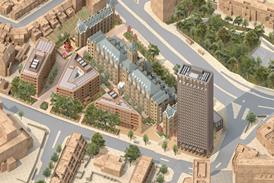Michael Walters sets out how the Trump administration’s apparent tariff exemption for pharmaceuticals could offer a unique opportunity for the life sciences sector – and for the architects shaping its future

Donald Trump’s imposition of import tariffs on countries across the globe has dominated the headlines and caused significant turmoil in the markets. However, what hasn’t received much reporting is the apparent tariff exemption given to the life sciences sector.
As the UK continues to reposition itself post-Brexit, this latest development could in fact signal opportunity, not just for drug manufacturers and researchers, but for architects, developers and contractors helping to shape the spaces where life sciences innovation happens.
In a sector already worth tens of billions to the UK economy, the removal of trade barriers has the potential to accelerate investment, reshape infrastructure needs, and develop how we design for science. As a new phase of global competitiveness begins, the construction and property industries must be ready to build what the life sciences sector needs.
At the heart of this development is greater international accessibility. With fewer trade barriers, UK pharmaceutical and biotech firms are better positioned to export products and form global partnerships, particularly with the US, which is a key market. This could lead to expansion and further collaboration, both of which require physical space.
Increased global interest in the UK as a base for pharmaceutical operations, together with reduced import costs on pharmaceutical ingredients and materials, could free up capital for companies. This would allow them to invest more heavily in infrastructure and expansion. It is also likely to drive demand for the high-spec lab spaces, R&D campuses and advanced manufacturing facilities already in the pipeline.
That, in turn, may provide the confidence to push ahead and build. For developers, this could translate into a fresh wave of construction activity that can support research, production and distribution.
Those building for life sciences must think strategically
A tariff-free pharmaceutical market may offer advantages for global imports but could also introduce new competition, with large multinationals entering the UK market and putting pressure on domestic pharmaceutical manufacturers. This tension could shift how and where manufacturing investment happens.
From a construction standpoint, there’s a potential contradiction: will pharma companies invest in UK-based manufacturing sites, or simply import more products due to reduced costs?
For the construction industry, this adds a layer of uncertainty. Those building for life sciences must think strategically, particularly about how their facilities can pivot between research, production, and even commercial or educational uses as markets shift.
Even with tariffs removed, supply chains remain vulnerable to disruption. The pandemic exposed the fragility of global logistics, and resilience is now top of the agenda.
That means a renewed focus on domestic manufacturing capacity, storage infrastructure and logistics facilities – all of which must be delivered with speed, precision and long-term sustainability in mind. Architects, engineers and contractors play a critical role in delivering buildings that support this resilience.
The UK’s emergence as a tariff-free player in global pharmaceuticals represents both an opportunity and a challenge for the built environment
Also, post-Brexit, the UK is no longer part of the European Medicines Agency, creating a separate regulatory pathway under the UK’s own Medicines and Healthcare products Regulatory Agency. This divergence can mean longer timelines or added costs for companies operating across UK and EU borders. For architects and project teams, it introduces another design consideration: facilities must increasingly be “dual-ready”, able to meet the regulatory standards of both regions.
The design challenge lies in combining technical performance with long-term adaptability. Life sciences companies are evolving fast, and facilities need to be designed that are capable of supporting workflows, equipment and innovations that don’t even exist yet. Agile design principles, modular construction methods and integrated digital technologies will be critical to staying ahead.
Spaces for clinical trials, R&D and manufacturing need to be robust, futureproofed and designed with multiple regulatory frameworks in mind. This presents a clear opportunity for specialist consultants and multidisciplinary teams to lead the way in designing environments that support compliance while maintaining innovation and efficiency.
The UK’s emergence as a tariff-free player in global pharmaceuticals represents both an opportunity and a challenge for the built environment. It calls for spaces that can meet the technical demands of science, the regulatory complexity of international trade, and the design sophistication required to attract world-class talent.
If the UK can strike the right balance between global openness and domestic capability, the life sciences sector could define the next great chapter of industrial development. And for the architecture and construction industries, that means a chance to shape not only buildings, but the future of innovation itself.
>> Also read: Trump tariffs could make investors pause funding for major schemes, experts warn
>> Also read: Why architects must confront the changing political landscape
>> Also read: Trump’s return: US architects brace for challenges over the next four years
Postscript
Michael Walters is Group Director of Corstorphine & Wright
















No comments yet